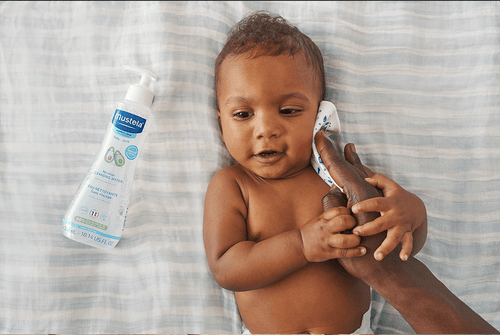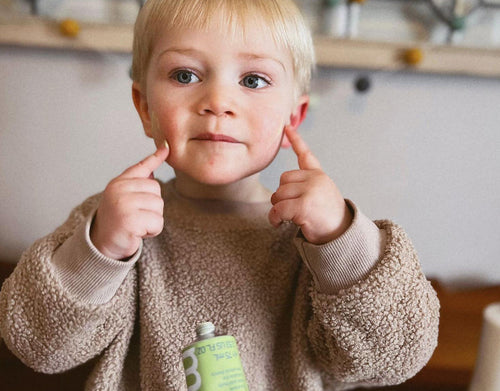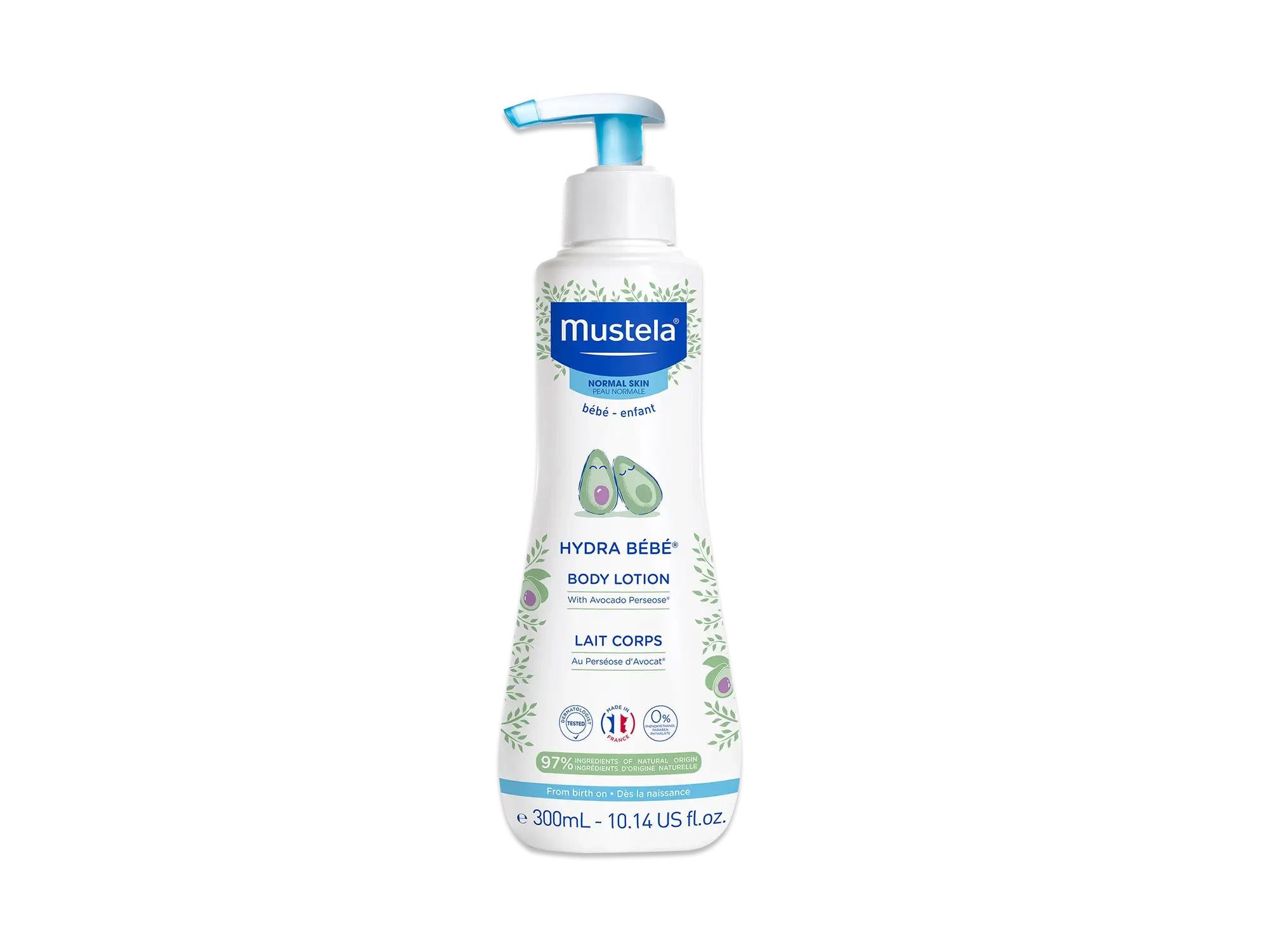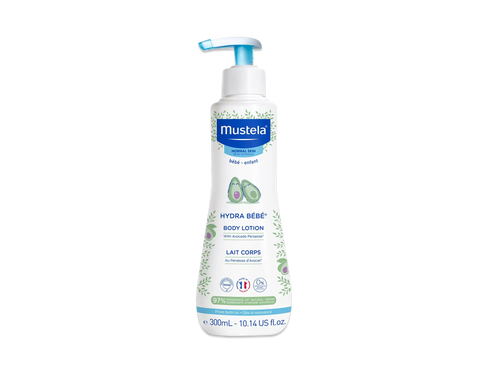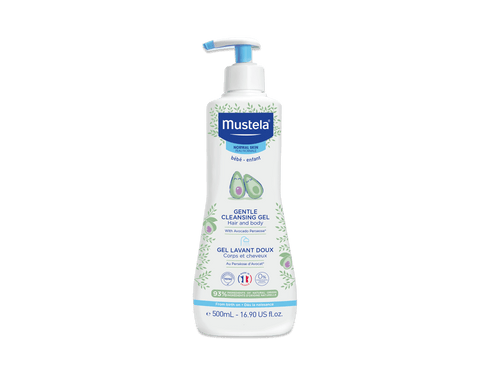Taking care of your child’s skin is a big part of keeping them healthy and happy, but where do you start? With so many products and conflicting advice, it can be challenging to figure out the best skin care for kids.
But don’t worry; we’re here to help! For over seventy years, we’ve manufactured clean and gentle skin care products for newborns and the whole family, giving us a deep understanding of the best practices for kids’ skin care.
In this guide, we’ll dive into the dos and don’ts of a kid-friendly skin care routine and provide tips on keeping your child’s skin soft, healthy, and protected.
Key Takeaways
- A child's skin is more delicate and sensitive than an adult's, so it needs extra protection. Since it's still developing, it's more susceptible to dryness and irritation. Establishing a routine early strengthens the skin barrier and teaches lifelong habits.
- To keep your child's skin healthy, you don't need a lot of products. A minimalist approach is best. Use a gentle cleanser for bathtime, moisturize to lock in hydration, and protect them from the sun with a broad-spectrum mineral sunscreen.
- Look for products that contain natural ingredients such as avocado, sunflower oil, aloe vera, and shea butter. Avoid anything with parabens, phthalates, phenoxyethanol, or alcohol, as these can irritate your child's delicate skin.
- Use lukewarm water and limit baths to no more than 10 minutes to prevent stripping the skin of its natural oils. When drying, pat the skin gently with a soft towel instead of rubbing, and avoid scrubbing too hard during cleansing.
Why Kids Need A Skin Care Routine

Before diving into specific steps, let’s discuss why a skin care routine is essential for kids.
Like adults, your child’s skin is the first line of defense against environmental factors and germs. However, because their skin is still developing, it can be more sensitive to irritants. Establishing a skin care routine early on can help boost their natural skin barrier.
Let’s take a deeper look.
Protect And Maintain Their Skin
The skin barrier acts as a protective shield against bacteria, viruses, and other harmful substances. It also helps to retain moisture, keeping the skin hydrated and healthy.
A simple skin care routine will help your child develop and maintain a strong skin barrier.
Teach Healthy Habits From An Early Age
Creating a skin care routine for kids isn’t just about the products they use and the steps they take. It’s also an opportunity to teach your little one healthy habits that’ll benefit their skin in the long run.
By instilling these practices early on, you’re setting your child up for a lifetime of good skin health.
Kids’ Skin Care Needs

Your child’s skin isn’t just a smaller version of an adult’s. It has unique needs to consider before creating a skin care routine.
Why Kids Need Different Skin Care Than Adults
When your baby is first born, their skin is thinner and more delicate than an adult’s. It takes time for their skin to develop and mature, so it needs extra protection and care.
Throughout childhood, their skin produces less natural oil and is more susceptible to dryness and irritation. As they enter their teen years, hormones cause changes in the skin, which can lead to acne or breakouts.
Different Skin Types In Kids
Your child’s skin type will also affect their skin care routine. As with adults, there are several skin types: normal, dry, eczema-prone, and very sensitive.
Let’s look at each one more closely.
Normal Skin
Normal skin is typically soft and smooth. It’s not too dry or sensitive and has no visible blemishes or irritations.
Of course, normal skin for a kid is still developing, so it’s more delicate than that of an adult. You’ll want to be mindful of the products you use and avoid harsh or synthetic chemicals.
Dry Skin
Dry skin lacks moisture. It may feel tight or rough and can also be flaky or itchy. Most babies are prone to dry skin, but it can be an ongoing issue for some children throughout childhood.
To combat dryness, look for moisturizing products specially designed for kids, with gentle and nourishing ingredients like avocados and sunflower seed oil.
Eczema-Prone Skin
Eczema is a common skin condition in babies and children that causes red, itchy patches. If your child is prone to eczema, their skin care routine must be gentle and non-irritating.
Look for products with the National Eczema Association's Seal of Acceptance, such as the Stelatopia Collection from Mustela.
We’ll discuss eczema in a bit more detail in the next section.
Very Sensitive Skin
Some children have extremely sensitive skin that reacts quickly to irritants. This may include certain fabrics, detergents, or environmental factors like heat or cold. If your child has very sensitive skin, you’ll want to look for hypoallergenic and fragrance-free products.
You’ll also want to do a patch test with any new product before using it. Apply a small amount to the inner arm and wait 24 hours to see if a reaction occurs.
Common Skin Problems And How To Help

Whether your child has normal, dry, eczema-prone, or sensitive skin, certain problems are common as they grow. It can be stressful when these issues pop up, but rest assured that you can treat them at home or, in some cases, with help from your family doctor.
Diaper Rash
Diaper rash is a big one, and most babies develop it at some point until they’re potty trained. Symptoms include red, irritated, uncomfortable skin around your baby's bottom, legs, and tummy. Diaper rash can be caused by wetness, chafing, and/or new foods.
Wetness: Wetness is, by far, the biggest cause of diaper rash and occurs when a wet or dirty diaper stays in contact with your baby’s skin too long. Do your best to change your baby’s diaper as soon as you suspect it’s dirty.
Chafing: Sometimes, the diaper itself may not fit right and can rub against their delicate skin, causing irritation. If you’re diligent about changing their diaper as soon as it’s dirty, consider trying a different type or size of diaper to see if it helps clear up the problem.
New foods: When you introduce new foods, your baby’s bowel movements can change, which may lead to diaper rash.
You can treat the rash itself with diaper rash cream to keep your baby comfortable, but the problem will likely go away on its own as your baby gets used to the new foods.
In some cases, a diaper rash can turn into a yeast infection. This often looks like a bright red rash with small bumps, especially in the folds of the skin. If you think your baby has developed a yeast infection, make an appointment to see a doctor as soon as possible.
Bottom line: The best way to fight diaper rash is to keep the area clean and dry. Change diapers as soon as they are wet or soiled. Gently clean the area, pat dry with a soft towel, and apply a diaper rash cream with zinc-oxide when necessary.
Giving your baby "diaper-free time" is also a great way to help fight diaper rash. Let your little one play on a towel for a few minutes to help their skin breathe.
Heat Rash
Heat rash, or prickly heat, looks like small, red bumps and can make your child's skin feel itchy. It’s most common in hot, humid weather or if your child has on too many layers. When that happens, moisture and sweat can get trapped in the pores and irritate your baby’s skin.
The best way to prevent heat rash is to keep your child cool. Dress them in loose, lightweight clothing and make sure their room isn’t too hot.
If they do get a heat rash, a cool bath can do wonders. Once the moisture and sweat are gone and the skin cools down, the rash will usually go away on its own.
Eczema
As we mentioned earlier, eczema is a condition that makes your little one’s skin red, itchy, and dry. It's common in babies and children, and can be frustrating to deal with when it first appears.
Kids with eczema often have a problem with their skin barrier, which means their skin loses moisture more easily and is more sensitive to allergens in their environment. Eczema will often appear on the face, scalp, elbows, and behind the knees.
The most important thing you can do when eczema breaks out is keep your child’s skin moisturized. Use a thick cream or ointment, especially right after baths when their skin is still a little damp.
Also, try to identify and avoid things that trigger the eczema, like certain soaps, detergents, or fabrics.
To make that process easier, always look for products with the National Eczema Association’s Seal of Acceptance. These products are made to be gentle on sensitive, eczema-prone skin.
For more information on eczema and eczema-prone skin, check out these articles from the Mustela blog:
-
What Is Eczema: Causes, Symptoms, And Treatment
-
A Parent’s Guide To Baby Eczema: Causes, Symptoms, Treatment & Prevention
- Monitor Your Baby's Environment to Prevent Eczema Flare-Ups
And that’s just the tip of the iceberg! Click here for even more information about baby and child eczema.
Ingredients To Look For
When selecting skin care products for kids, it’s important to read the label and look for specific ingredients that benefit their skin.
Prioritize natural ingredients like:
-
Avocado Perseose®: Helps strengthen your baby’s skin barrier to protect their immature skin.
-
Sunflower Oil Distillate: Highly moisturizing extract that can soothe skin and replenish lipids.
-
Aloe Vera: Known for its soothing and moisturizing properties, aloe vera contains powerful antioxidants like Vitamins C and E that help strengthen skin.
-
Jojoba Oil: This oil closely resembles the natural oils on our skin, making it a gentle and effective moisturizer.
- Shea Butter: A natural emollient that helps keep skin soft and supple.
Simple Daily Skin Care For Kids
No need to overcomplicate things — skinimalism is a growing trend in skin care, and it’s perfect for kids! Follow these three steps to keep your child’s skin healthy and happy.
Cleanse

Babies and young children don’t need to bathe every day, but it’s important to keep their face, hands, and diaper area clean. Use our No Rinse Cleansing Water or Home Compostable Wipes to clean and refresh your child’s skin between baths.
For bathtime, you can use one of our cleansing gels. Pick the one that corresponds to your child’s skin type:
-
Gentle Cleansing Gel
-
Soothing Cleansing Gel
-
Nourishing Cleansing Gel with Cold Cream
- Stelatopia Cleansing Gel
Older kids might prefer our Shampoo & Body Cleansing Bar or Organic Cleansing Gel with olive Oil and Aloe.
When your child gets out of the tub, teach them to pat themselves dry with a soft towel instead of rubbing. This will help prevent irritation.
Hydrate

After bathing and at least once a day, moisturize your child’s skin with a gentle lotion or cream to lock in moisture. Keeping their skin hydrated can help prevent dryness and irritation.
Choose a product specifically designed for babies and children, like our Hydra Bebe Body Lotion or Nourishing Stick with Cold Cream.
Pay special attention to areas prone to dryness, such as elbows, knees, and cheeks. These areas may need extra moisturizer throughout the day to stay hydrated.
Protect

The final step in our skin care for kids routine is protecting them from the sun’s harmful rays. For babies six months and older, quality sunscreen is an essential part of their daily routine. Our broad-spectrum Mineral Sunscreen helps block UVA and UVB rays.
Putting sunscreen on each day might seem like a hassle, but it’s important. Teaching your kids to protect their skin now may help them avoid sun damage in the future.
To simplify this step, consider using our SPF 50 Mineral Sunscreen Spray. It makes application a breeze.
What To Avoid
While establishing your child’s daily skin care routine, there are a few things you’ll want to avoid.
Harsh Ingredients
Avoid products with harsh ingredients such as:
- Parabens
- Phthalates
- Phenoxyethanol
- Alcohol
Hot Water
Hot water can strip the skin of its natural oils and cause dryness. To keep your baby’s skin softer, stick to lukewarm baths and showers.
Long Showers Or Baths
Spending too much time in the water can also dry out your baby’s skin. Limit their time in the bath or shower to no more than 10 minutes. And remember to help them moisturize after they get out!
Scrubbing Too Hard
Gentleness is key when it comes to skin care for kids. You don’t want to scrub too hard with a washcloth or loofa, as this can irritate their thin skin. Instead, use gentle, circular motions with a soft cloth.
Making Skin Care Fun
A daily routine may sound boring, but it doesn't have to be! You can turn skin care into a fun time for your kids.
At bathtime, add some bubbles or bath toys to make it more like playtime. Let your child help wash themselves with a gentle cleanser and a soft washcloth.
After the bath, turn moisturizing into a game. Let them put lotion on your hands or feet, and you can put it on theirs. Come up with a special song you can both sing to make “lotion time” even more fun.
When it's time for sunscreen, call it "sunscreen painting." Let your child “paint" their own arms and legs with the lotion or spray. Then, you can “paint” the hard-to-reach spots.
During storytime, make up stories about why their skin needs protection. For example, pretend that the sun is a big, friendly dragon whose breath gives off lots of heat and the sunscreen is a magic shield!
By making these steps fun, you're not just taking care of their skin; you're also teaching them to enjoy and be in charge of their own health.
Mustela Makes Skin Care For Kids Easy!

Our goal at Mustela is to make skin care for kids simple and stress-free for parents. By selecting safe, gentle, and effective ingredients in our products, we make it easy to establish a daily routine to keep your child’s delicate skin healthy and protected.
Additionally, all of our products are pediatrician- and dermatologist-tested so you can trust they’re safe for your baby’s delicate skin. From bathtime to boo-boos, Mustela has everything you need to care for your child’s skin.
So stock up on some basics, like our No Rinse Cleansing Water, Hydra Bebe Face Cream, and SPF 50 Mineral Sunscreen Lotion, and get started with the simple, three-step skin care routine listed above. Trust us, your little one will thank you for it!
Frequently Asked Questions
How can I prevent and treat common baby skin issues like diaper rash and baby acne?
Diaper rash: The best way to prevent diaper rash is to change your baby’s diaper as soon as you suspect it’s wet or dirty. This will help keep the area clean and dry.
Clean the area with a gentle wipe or a wet cloth, pat dry with a soft towel, and then put on the diaper. It’s also a good idea to allow some diaper-free time now and then to let the skin breathe.
If a rash does appear, apply a layer of diaper rash cream and, again, give your child a bit of diaper-free time. If the rash persists or looks like a yeast infection, it’s time for a doctor visit.
Baby acne: Baby acne is very common and usually harmless. It’s caused by overactive oil glands and will typically clear up on its own in a few weeks without any treatment.
Avoid using over-the-counter acne treatments or harsh soaps, as these can irritate their delicate skin. Gentle cleansing with water or a mild baby cleanser is all that they need.
If the acne persists or gets worse, speak with your pediatrician.
Do I need to use multiple products on my baby’s skin?
You really don’t! Using too many products can actually irritate your baby’s skin and cause baby acne, rashes, and other conditions.
Stick with the basics. A simple routine with a gentle cleanser, a baby-friendly moisturizer, and an SPF 50 or higher sunscreen is the safest and most effective way to keep your little one’s skin healthy.
When should I take my child to a doctor if I think they might have a skin problem?
If your little one develops a diaper rash, dry skin, or baby acne, try treating the problem yourself first. For diaper rash, apply a diaper rash cream. For dry skin, apply a baby-friendly moisturizer. For baby acne, the best thing you can do is let it work itself out.
If any of the issues persists longer than a week, gets worse, or causes significant discomfort, schedule an appointment with your doctor or pediatrician.
If a skin problem is accompanied by a fever, signs of infection, or symptoms of an allergic reaction, take your child to the doctor as soon as possible.

